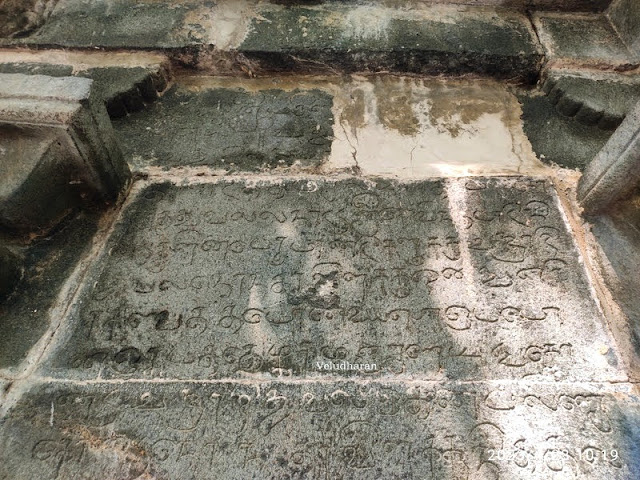21st February 2020, A 18th
March 2018 post updated.
The list of Shiva temples in and around
Kanchipuram with links to Google Photos, Location links on Google Maps, and
Location QR Codes are posted already in this blog. We have not visited this
temple during this Maha Shivaratri Day. Some of the details are added in my
previous post.
After visiting
the Konar temple, on the way to Kanchipuram, we noticed a dilapidated Shiva
temple with Shiva Lingam outside and a new temple close to each other ). This
temple is a part of Kanchipuram Temples. The
18th Century Sri Sivagnana Swamigal has sung the sthala Puranam of this temple in Kanchipuram under Parasurameswara Padalam. Out of 62 songs, 6
are reproduced as given below...
43. பரசிராமேச்சரப்
படலம் (1512 - 1573)
1512 சுழிபாடு படுமுந்தி மலைமகளும்
யோகியரும் துழாயி னானும்
வழிபாடு செயைவகும் மணிகண்டர்
மாற்பேறு வகுத்தாம் பண்கள்
கொழிபாடற் சுரும்பினஞ்சூழ் மருப்பொதும்பர்
மாற்பேற்றின் குணபால் வேந்தர்
பழிபாடிக் கொலைசெய்தோன் பரசிரா
மேச்சரத்தின் பான்மை சொல்வாம்.
1513 இரேணுகை கொலையுண்டு எழுதல்
சிவம்பழுத்த பிருகுமுனி இடுஞ்சாபத்
தொடர்ச்சியினால்
திருமால் முன்னாள்
தவம்பழுத்தா லனையசம தக்கினியோ
டிரேணு
கைக்குத் தநய னாகி
அவம்பழுத்த குறும்பெறியும் இராமெனன
வைகுறுநாள்
அன்னை பாலோர்
நவம்பழுத்த தீங்குணர்ந்து தன்தாதை
தனையேவ
நாடித் தேறி
1514 தாதைமொழி கடவாமை தருமெமனத்
தனையீன்று வளர்த்த தாயை
ஏதமுறக் கொலைசெய்து முனியருளால்
மீண்டுய்ய எழுப்பி நின்றான்
மேதகைய முனிமகிழ்ந்து வெகுளிதனை
அறவிடுத்துச் சமாதி மேவும்
போதவனை வெகுண்டெய்திக் காத்தவீ
ரியன்கோறல் புரிந்தான் மன்னோ
1515 பரசிராமன் தவம் புரிதல்
மிடல்படைத்த திறல்திண்டோள் இராமனது
நோக்கிநெடு வெகுளி மீக்கொண்
டடல்படைத்த வயவேந்தர் குலமுழுதும்
இறுப்பேனெனன் றார்த்துப் பொங்கிக்
கடல்பைடத்த விடமயின்றோன் அருள்வேண்டி
விரைந்தெய்திக் கலந்தார் தங்கள்
உடல்படைத்த பேறெய்துங் காஞ்சியினோ
ரிலிங்க மமைத் தருச்சித் தேத்தி
-------------- ----------------- ---------------
1571 எனவேண்டி வணங்கி வணங்கி யெழுந்த காலை
முனிவன்றனக் கவ்வரம் முற்றும் வழங்கி மூரிப்
பனிமால்வரை நல்கிய பைந்தொடி மைந்த ரோடும்
அனலங்கைகொல் அண்ணல் கரந்தபின் னங்கண் நீங்கி
1572 முனிவன்முனி வன்மழு வான்மணி மோலி வாய்ந்த
சிவனெம்படை வேந்தர் தமைச்செரு விற்படுத்துக்
கனலன்ன செழுங்குரு திக்கய நீரிறைத்திட்
டினமன்னு பிதிர்க்கட னாற்றிமெய் யின்ப முற்றான்
1573 அப்பொற்பின் அருட்சிவ லிங்கம்மெய் யன்பி னங்கண்
எப்பெற்றிய ரேனு மிறைஞ்சின விறைஞ்சு முன்னர்க்
கைப்பட்டேதா ராமல கக்கனி போல வீடும்
செப்பற்கரி தாகிய செல்வமு மெய்தி வாழ்வார்.
Moolavar : Sri Parasurameswarar
Consort : Sri PerungKarunainayaki
Some of the important
features of this temple are …
The temple faces west with a simple 3-tier Rajagopuram without any stucco images. The temple is
also very simple with Amman and Bhairavar Sannidhis. In koshtam Vinayagar, Dakshinamurthy,
Mahavishnu, Brahma and Durgai. The temple is not an old one ( as claimed by
Babaji 25 lakhs years old ) and might have been reconstructed in recent years.
Parasuraman, balipeedam
and Rishabam are in front. Vinayagar and Murugan are in front of the sannadhi. 27
nakshatra trees are grown around the compound wall and the special trees are
Thiruvodu maram and Rudraksha tree. Mandapam construction was in progress
during our visit.
LEGENDS
As per the legend, Sri
Parasurama as Rama was born to Sage Samathgini and Renuka. Renuka used to make
pots out of sand and bring it to pooja. One day she couldn’t do so, since she
admired the Devas beauty, who was on the flying Chariot. So, Sage Samathgini
ordered Rama to kill his mother. But later Sage gave life as per Rama’s request.
In another instance, Sage Samathgini had a Cow, who gave good food that the sage wanted. When the King
of that region asked to give the cow, the Sage refused. The King took away the
cow forcibly after Killing the sage. Rama did a penance on Lord Shiva. Rama and
Lord Shiva as Hunter fought with each other. Finally, Lord Shiva gave him the
Parasu as a boon and called Parasurama. Parasurama killed the King, who
killed his father. Parasurama came to Kanchipuram and established the Shiva Linga to
remove the sin caused by to Killing of his mother and the King.
TEMPLE TIMINGS:
Since the temple is a little away from the main roads devotees are advised to contact before going to
the temple.
CONTACT DETAILS:
Acharya
Babaji 9840848127 and 9962633220
Face book :
parasurameswarartemple
e-mail
: parasurameswarartemple@gmail.com
HOW TO REACH:
About 3 km from
Thirumalpur Railway Station.
Share autos are
available from Thirumalpur Railway station to Thirumalpur and the temple is on
the left side in the midst of fields.
The temple is 15 km from Arakkonam Junction, 17 km from Kanchipuram, and 70 km from Chennai.
The Nearest Railway Junction is Arakkonam and the station is Thirumalpur.
LOCATION OF THE TEMPLE: CLICK
HERE
This stone tub has an inscription starting with Swathi Sri..
might have been brought from the old temple (this may be the only material to
prove that the original temple is old maybe it was during Pallava or Chozhas )
CRESCENTIA CUJETE- The CALABASH tree a native of Hawaii is called wrongly by the locals as beggar bowl.
Just
before this new Sri Parasurameswarar temple, there was a dilapidated brick
temple that might have been constructed during the Chozha period. A large peepal tree was
grown on the Vimanam and seems that the structure may collapse at any time.
Vegetation was grown inside and outside, which obstructs the entry to the
structure. Rishabam is in damaged condition. Shiva Lingam was taken
out of the sanctum and kept open to the sky.
---OM
SHIVAYA NAMA---































































